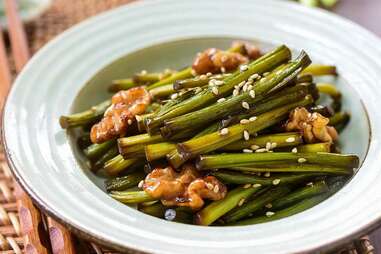Why We’re Overjoyed Garlic Scape Season Is Upon Us
These unsung curly green stalks are great in stir frys, on salads, or made into pesto.
We get it. Ramps are really good. But there’s another allium out there that deserves equal attention: the garlic scape. And unlike the ramp, which, in its wild state, can suffer from overharvesting, the garlic scape is actually a byproduct of hardneck garlic that just so happens to be a standout delight on its own.
“Garlic scapes are a treat that most people haven’t tried,” says Kevin Espiritu, founder of Epic Gardening, an online resource for at-home gardening. “And they’re best fresh from the garden, because they don’t store well and need to be used within 48 hours of harvest for the best taste and texture.”
What exactly are garlic scapes?
Garlic scapes are the shoots or stems that grow straight out of a hardneck garlic plant. These stems form an umbel, or bulb, that eventually produces flowers. The scapes are harvested in late spring and early summer, a few weeks before the actual garlic is harvested.
Though they haven’t quite received their claim to fame in the U.S., garlic scapes are much more ubiquitous in various parts of Asia. “They’re a highly popular vegetable in Korea,” says Hyosun Ro, the blogger behind Korean Bapsang. “Koreans eat a lot of garlic, so there’s a lot of garlic being grown.”
The harvesting of garlic scapes is particularly interesting, because removing the stem from the plant actually creates better-tasting garlic. “When you grow garlic, you don't want the garlic plant to spend energy on producing flowers, right?” Ro explains. Once removed, the main garlic bulb becomes the center of attention.
What do garlic scapes taste like?
But the scape is far from a throw-away. These green, Medusa-like curlicues have a delicate garlic flavor—not as pungent as the bulb, but still quite peppery, earthy, and nutty. Ro compares their texture to a thin asparagus, though more resilient and easily bendable. Garlic scapes are rich in Vitamins A and C, as well as fiber and antioxidants.

How to get your hands on them
If you happen to be harvesting garlic at home, Espiritu recommends picking the scapes once a complete curl in the stem has formed. “However, they can be harvested as soon as you can see the onion-like flower head and as far out as 3-4 curls of the stem,” he says. “To harvest, you cut at the base of the stem where it comes out of the main stalk.”
If you’re looking to purchase your garlic scapes, your best bet is a Korean grocery store or a farmer’s market. “But I sometimes see them appear at American grocers, like Whole Foods, at the peak of the season,” Ro adds. So make sure to stock up once you spot them.
You’ll want to look for extra-green scapes—not yellow, which usually indicates they’ve sat out for too long and are not as fresh. And the thinner, the better, “because thin usually means tender,” Ro says. If kept in the fridge, your scapes can last for a week or two.
How to incorporate garlic scapes in recipes
If you happen upon some tender scapes, you can eat them raw, in the same way you would chives or scallions, for a stronger taste. But Ro explains that, once you reach the end of the season, the scapes tend to get a bit more tough, so it’s best to cook them.
In Korea, you’ll likely find garlic scapes stir-fried, or simply blanched and seasoned with gochujang. Ro likes to stir-fry her garlic scapes with walnuts for a quick and easy banchan, while Espiritu incorporates them in just about any meal.
“You start by cutting them into green bean sized lengths, then bathe them in salted boiling water for 1-2 minutes,” he says. “Throw them into a hot pan with oil and cook for a few minutes, stirring a lot, and pull them out when they are a little caramelized. They can be eaten plain, added to a salad, or used as a bed for meats.”
Ro also enjoys grinding the scapes up to make a pesto, or tossing them into a simple brine of vinegar, soy sauce, sugar, and water. “Before the season is over, I definitely make sure to pickle my garlic scapes,” she says. They’re just too good to not have year-round.
